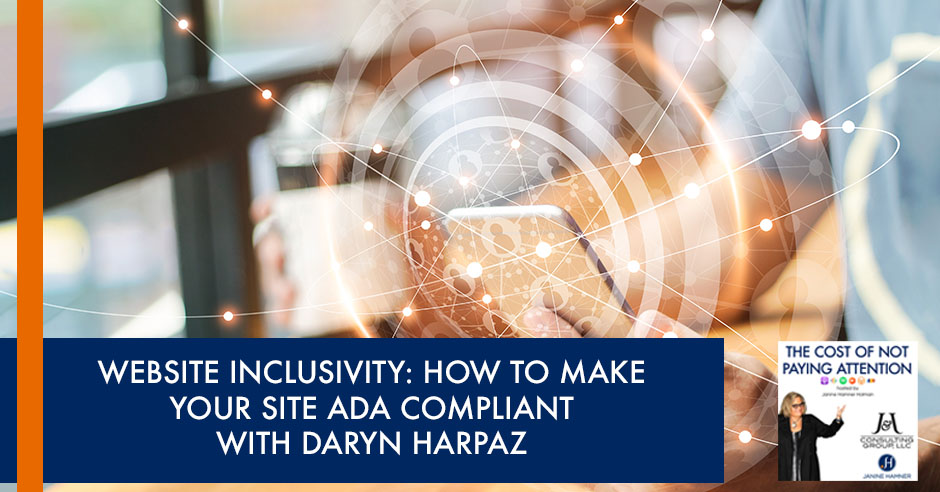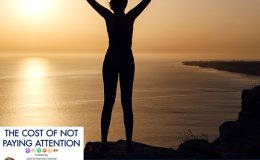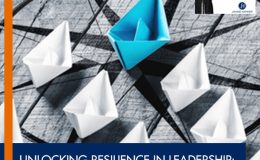
We often hear of people advocating for diversity and inclusivity on the streets, but this time, we hear it from Tech Advocate, CEO, and Founder of Zenyth, Daryn Harpaz. Daryn talks about how you can make your business digitally inclusive and accessible for people of all abilities. He also shares how you can improve your website and mobile application’s user experience, increase profitability, and avoid the hassles of possible lawsuits and fines for compliance issues. Tune in to today’s show and learn what user-friendly truly means.
GUEST: Daryn Harpaz | LinkedIn | Visit Daryn’s Website: Zenyth
HOST: Janine Hamner Holman | Janine@JandJCG.com | LinkedIn, Facebook, Instagram, and Twitter |
—
Listen to the podcast here
Website Inclusivity: How To Make Your Site ADA Compliant With Daryn Harpaz
Welcome to the show. What am I paying attention to now? The things that we do not know that we do not know.
There are things that we know that we know. I know that I know how to drive a car. I am quite clear on how to drive a car. I know that I do not know how to fly an airplane. If I have to fly an airplane, we are all in trouble because I do not know how to fly an airplane. There is this whole other category of the things that we do not know that we do not know. The first time that I met our guest, Daryn Harpaz, I realized that there was this entirely different category: things that I did not know that I did not know. I am excited to get to eliminate some things from this category for myself and, hopefully, for you all as well.
Daryn Harpaz created Zenyth because he is on a mission to have the internet be accessible to people with disabilities. As an accessibility expert, Daryn helps organizations achieve ADA compliance for web and mobile applications by keeping their digital platform current with the latest standards. He brings deep expertise in ADA website accessibility and compliance, and a passion for helping organizations achieve and maintain digital conformance to his work. I did not even know that this was something that we were supposed to be paying attention to. I have two websites. I am 100% sure that they are not ADA compliant. I am excited to get to dig into all of this with our guest for this episode. Welcome to the show, Daryn.
Hello, Janine. What a lovely introduction; I appreciate the warm welcome. Thank you so much for having me on your show. I love your framework of what we do not know what we do not know. It is so apt for this conversation.
Let’s get into this thing to which I am certain that I am not the only person who has not been paying attention. This is a place where we all get to pay attention. Help me and our readers get present to what it is that you do.
Let’s take a journey. A little background here, the Americans with Disabilities Act is the umbrella or the framework for what we are talking about. It was enacted in 1990. At that time, there was no internet. They could not envision that a digital world would exist where the ADA would apply to websites. We are in this Wild Wild West fluctuation point where all the laws have been created but do not apply to the modern world. This has come about, unfortunately, in the worst way. It has come out from the litigious perspective. Over litigious plaintiff attorneys will find visually impaired plaintiffs to work with and identify websites that are not accessible to visually impaired users.
A user with vision impairments will use a screen reader or assistive technologies and a keyboard to navigate a website, as opposed to regular-sighted users who would use a monitor and a mouse. They identify the site is not working because most sites are not. They file a claim that could be in the form of a demand letter, which is where we are putting a notice that your site is not ADA compliant. If you do not pass us a certain amount of money, we are going to take this to court. The truth is that most of these claims settled tens of thousands of demand letters that are circulating out there at any given time. Some do make it to the settlement phase. For the most part, these things get paid and moved on. We see some getting through where case law and precedence get set. That is the backdrop to the mayhem and the chaos behind the scenes.
Let me ask you a question about that. If I were to get a demand letter, my first response to that would be that somebody is saying I am doing something wrong. I would feel bad about that. Also, this is a legal matter so I would contact my attorney, but it sounds like what they are asking for is financial remuneration and not fixing your website. Do I have that right? This is an opportunity for lawyers. I have many lawyers who were very good friends, so this is not a slam on lawyers, but this is a financial strategy and not a, “Let’s make websites ADA compliant strategy,” or do I have that wrong?
Unfortunately, a large portion of that statement is accurate. There are 10 or 15 law firms across the nation that are responsible for approximately 80% of these lawsuits. Some law firms have taken to becoming serial filers and some plaintiffs and visually impaired plaintiffs have had hundreds of cases that they are filing under the umbrella of these overly litigious law firms. There are some wonderful law firms representing both the plaintiff and the defense legitimately. For the most part, it is tainted by a small yet very overly litigious and aggressive plaintiff strategy.
That is an accurate assessment. The way we see this playing out is you get a demand letter. Your first instinct is typically to call your lawyer or call the person who built your website. Here is the intersection. This is where it all comes together in the framework of your show, what we do not know. The agencies at both websites did not know about website accessibility. The graphic designers, when they were first putting the very first pixel down for the color palettes, the font selection, and the beautiful design and user experience did not know. These sites get built with no accessibility in mind. You are looking at reverse-engineering the designs of almost every site out there to achieve ADA compliance. How do you do that?
When you are either remediating or trying to make a site ADA-compliant or building a site from scratch, you have to start with an audit methodology. Share on XThat is a big challenge. What do we do?
We enter the methodology or the process. As we continue down this journey of discussing and unwrapping the nuances of our industry, I will explain how there are some deviations and splits between approaches and best practices that are causing an even further rift in the integrity of website accessibility and compliance. The first riff is on the legal side. We are talking about the first phase of the process, which is the order. That is the only way to get under the hood and figure out what defects exist and why this website is not ADA compliant.
Earlier, we referenced the ADA. Under the ADA, the Americans with Disabilities Act, there is a standard that has been produced and developed by the W3C, the World Wide Web Consortium, called WCAG or the Web Content Accessibility Guidelines. It is the adopted standard for principals and success criteria. In order to make this element accessible, it should meet the success criteria. This guideline should be present. If you do this correctly, it will pass and be considered ADA compliant. That methodology.
Interestingly, the courts have agreed that WCAG is not the only way you can implement accessibility. If you find another way to achieve the same outcome, WCAG is not defined as the only approach, but it is the best and the most globally accepted. It has become standardized. We all tend to roll up to that. All countries have their own flavor, but they all essentially do roll up to the Web Content Accessibility Guidelines.
When we are thinking about accessibility, is it the lens that we are looking through for people who are visually impaired or are there other kinds of disabilities that we also need to be thinking about as we are in the process of web design and/or reviewing our websites?
The WCAG covers the spectrum, so visual, auditory, motor, and cognitive. The success criteria are crafted or developed to make sure that all these aspects of the disability spectrum are covered. The predominant disability is visual because the lawsuits are all starting with the claim that a visually impaired user who visited your website could not access the information with a screen-reader and keyboard controls, and that had to be non-compliant in addition to these elements. It tends to start there and, therefore, more gravity has been given to the situation to the user group of visual users.
We have low vision and poor vision users, who are not considered technically legally blind, but they would use the same assistive technologies. They might use screen magnification tools and screen readers as well. They might very much enjoy using keyboard controls as opposed to a mouse, which is often difficult to navigate with motor, cognitive, and visual impairments.

Website Accessibility And Compliance: There is a standard that’s been produced and developed by the W3C, the World Wide Web Consortium, called WCAG, the Web Content Accessibility Guidelines.
It is this whole area of things that I did not know I did not know. It is fascinating to me! I have created two different websites. We are getting ready to create a third. How do I know if my website is being created in a way that is ADA compliant? Is that something that my web designer needs to take on? Many of us, in so many different ways, are creating content out there. How do we know if what we are creating is ADA compliant before we get a letter saying that we are not?
I want to take a quick step back to a conversation around the first part of the process. The first part of an existing website needing to become ADA compliant starts with an audit. We rely heavily on using manual skills, the screen reader, the keyboard, and assistive technologies. A lot of companies are simply going out there and finding these automated tools. They are useful to a degree that can be found on the low-end 20% to 30%, and the high-end, with 40% of the defects. Being generous, even if these automated tools can find 40% of the defects, we have 60% of defects to be discovered manually.
To answer your question directly, when you are either remediating or trying to make a site ADA compliant and beginning a site from scratch, you must start with an audit methodology. Now you can audit design. It is called a brand audit. Have you heard of a style guide or brand guideline before? That very first pixel is where the accessibility conversation should begin, “Is this color from a contrast perspective going to work for people with visual impairments?”
Right when we are starting to think about, “What are the colors of my logo?” What are the colors in my brand?” We want to be thinking about like, “Is this shade of red, orange, yellow, purple, blue, or whatever the colors are that I want to use as my brand guide, something that can be detected by somebody with low vision abilities?”
That’s the first layer. As you start to have background colors with colors over them, buttons, text on buttons, links, lines, hovers. You want to make sure that the contrast ratios, which are a success criteria guideline, pass the 4.5:1 ratios for larger text. There are different requirements for smaller texts and whatnot. It begins with the very first pixel because the compliance issues that are missed in the design phase get built into the UI, UX, and get wrapped up in the development and code. In order to unravel that, you have to reverse engineer and deconstruct all the way back to that digital asset which is much more time-consuming and more expensive.
It would be better as we are building whatever the assets are that we are creating, that we know we are paying attention to this one thing. Many of us do not even know that we should be paying attention to it.
I would like to parlay that with how we define accessibility. The best practices are set at the intersection of accessibility and usability. The reason I say that is because if you look at the statistics, not just the disability statistics, but our demographics as well. We know that 1 in 4 US adults have a disability and it is trending up. That is over 61 million US adults. Over 40% of adults over the age of 65 have a disability because our population is an aging population.
It begins with the very first pixel because the compliance issues missed in the design phase get built into the UI or UX. Share on XDisability applies to the disabled community, but when I hit 50, I needed a pair of glasses. If I do not have my glasses, I go to the monitor and I have to make the font larger. On most websites as I increase the font size, the styling of the site breaks. It is a usability issue. We know that there are over a billion people worldwide that have a disability. It is a global issue. That is why I defined this as an intersection of accessibility and usability, which is a rather important conversation. I hope that I have answered your question directly, but, to be clear, you begin at the very first phase of the creative cycle.
I am getting ready to create a new website as I am creating a new organization that is focused on Diversity, Equity, Inclusion and Belonging. It will be very important for that website to be accessible. We are focused on inclusion and belonging. If it is not accessible, what the heck are we doing? I need to ensure that this is an arena that my web designer is familiar with. If they are not, then what do we do? Do we hire Zenyth? What do we do at that point?
We were bound in creating a design for that very purpose. We have two very distinct agency or channel partnerships. One is directly with a very deep network of attorneys and defense litigators that come to us the minute their clients receive a demand letter or are being sued. We take a look at the legal side of the equation. The other side of the partnership spectrum are the web developers, the graphic designers, and the agencies out there that do not have the knowledge and the resources which includes the time and capacity to take this in-house. We become a trusted partner in helping them implement our process and our approach and methodology to accessibility seamlessly throughout the organization and across the client’s websites.
That is only half of the solution. The other half has got to be education and knowledge transfer because that is how you move the needle. That is how we are going to move the needle on accessibility. The more knowledge, the more information we can share. For that purpose, we have built a full training platform. The curriculum follows all the best practices for WCAG across designing and building web and mobile and beyond. We are constantly conducting live training sessions and transferring knowledge to the people with whom we work, both clients and agencies, to move that needle in the right direction.
I want to take a pause in the nuts and bolts of this. I am curious. How did you get interested in this? What was your path to realizing, “There is a problem here. I want to be part of the solution.”
Let’s go down that path a little bit. It was very interesting. Spoiler alert, I had the same reaction when I first learned about it that you had. At the beginning of the company, we were a full web agency, web and mobile traditional. We had taken on a sizeable contract with large autism services provider in California. In the scope of work in rebuilding their website and trying to come up with a fresh brand, we were asking about customers and clients. Their clients are these amazing children with disabilities, autism, and other disabilities, some of whom I got to meet.
We are talking about the internet and the conversation came up about how difficult it is to use a website and how certain things did not work. I asked, “Why? Can you show me?” I had kids and children showing me the difficulty of using this website. We used them for our focus groups as well, which is a wonderful thing to do. I said, “What companies are out there tackling the solution?” I started researching. This was 2015. This was before the major lawsuit started. You do not just pick up the phone and say to a company, “I would like to talk to you about website accessibility,” because they do not know.

Website Accessibility And Compliance: WCAG covers the spectrum of visual, auditory, motor, cognitive, and success criteria, and are crafted or developed to ensure that all these aspects of the disability spectrum are covered.
The first couple of years were educational selling, “I am calling to educate you on what accessibility is.” Those first few customers who were in the space of selling services that need to be accessible were our first target clients. It grew from there. I remember our first proposal to a nonprofit organization. When we were awarded the contract, I asked him if they could give us some feedback on the selection process and why we were selected. Of course, we were so happy. They said that out of all five proposals, we were the only one that knew what accessibility was. Every other company was talking about cross-browser compatibility, responsiveness, marketing, SEO, ease of use, and user experience.
I realized it was in the infancy of the industry. That day, we rebranded the company to be 100% website accessibility-focused. Now, we are an end-to-end digital compliance provider. It is all we do. If you want a basic website or something that is not compliant, we are not the right company for you. Speaking to your point about building your DEI websites and those initiatives, you might not be on the risk profile or the risk spectrum of being sued.
It is the right thing to do, but also, when you think of the disability community, they are the most brand-loyal communities out there. When a provider makes their services accessible, because there are so few providers that do so, the community listens. They become great advocates and ambassadors for that brand. It is amazing. I might be a little bit low on the number but I believe that the combined spending power of the disability community is somewhere perhaps north of $500 million or even half a billion dollars. I might have that slightly off, but it is a large amount of money.
As we are thinking of organizations, if they are, or when they are, organizations that are focused on doing the best by their people in order to do the best for the organization. However, organizations are in the business of making business. They are in the business of having profits and selling something, ideas or tangible goods or services or whatever it is that they are in the business of. What I love about this is that just like Diversity, Equity, and Inclusion are good for business because businesses that are more diverse are 31% more bottom line profitable. What you are also telling me is that businesses that pay attention to ADA compliance on their website are more profitable because of the brand loyalty of this group of humans who are out there.
As an internal optimist, I would like to say, yes. I cannot qualify that across all industries, but we have seen the work we have done. We have seen clients report back to us that the brand has gained tremendous exposure because they couple it with marketing and social media press releases. They go out there and they are tied into their initiative campaigns or their DEI campaigns. It feeds positivity. If you simply take out the cost of fighting a demand letter or a lawsuit, and then having to work with all the players involved to get your site compliant, those are bottom-line dollars there. On that basis, you can make a direct correlation that it increases profitability. A lawsuit can cost you $20,000 to $100,000 or more. It is not cheap. It is worth paying attention to.
If we have a site that we have not yet built, I would imagine it is cheaper to bring you or an ADA compliance team in to help you build it from the ground up and make sure that it is ADA compliant versus retrofitting a site.
Not absolute, but on average, we see a new, built from the ground up, website increasing the cost of that website by about 30%. We do not consider that to be significant.
When providers make their services accessible, the community listens and becomes great advocates and ambassadors for that brand. Share on XIf you have got to go back and retrofit it?
Double or more, maybe even 120%. The reason I say that is because you have to do the audit first. The audit is a fixed cost. You must do the audit. You go to the garage and you say, “My car is making a noise, fix it.” We are going to take out the entire engine to get to the one bolt. Once you get the audit done, you have to decide who does the work. Are you hiring Zenyth to be your full code remediation partner or give you a site that is fully remediated back to you, or are you hiring Zenyth to provide the consulting support and the oversight to your development teams and guide them through fixing the issues? That is time and material. If your team does not know a lot, they need to learn more time.
The good news to that equation is over the long-term, your team becomes knowledgeable and empowered. We then turn regular designers and developers into advocates. We pass on the passion for accessibility. Every agency, designer and developer we work with is excited to learn and to take this on. It is not the same as gospel, but it is like spreading the good word. You are sharing the sunshine.
Suddenly, as a website developer and a graphic designer, you now have a new tool in your toolbox. You now have a new way to differentiate yourself in the marketplace. We will also ensure that your website is ADA compliant because now we know how to do that.
It is not all doom and gloom. We do risk assessments for companies all the time. For some companies, this goes back to the legal landscape, whether you are considered a place of public accommodation, which is a stage on being potentially sued. There is a short list of low hanging fruit or the quick things you can do to bring a little bit of compliance from a user experience and disability perspective to your site. Will it make you ADA compliant? No. Will it just help to enhance the user experience with people with disabilities? To a degree, yes.
I am happy to share those with any of your readers who might want to reach out and get some advice or talk. Usually, when I am chatting about accessibility, it is around the legal landscape and the risk and that whole side of the nuts and bolts. This conversation is a lot more on, “What is this?” Give us some insight into the inner workings of it,” which is refreshing
Please get in touch with Daryn. This is an important new thing that we did not know we were supposed to be paying attention to. I am so excited to have Daryn connected with you and to have the opportunity for this conversation. As we start wrapping up, is there anything that you were hoping to have the opportunity to talk about that we have not yet touched on? If you had a megaphone and could say one thing to folks out there, what would that be?

Website Accessibility And Compliance: Try and navigate the internet using a screen-reader and a keyboard. Take away your monitor and your mouse and figure out your user experience.
As a mouthpiece or a loudspeaker for accessibility, I would encourage any business owner to see what it is like to have a user experience from a visually impaired user perspective. If your agencies are working on this or if you know somebody who can guide you through this, try and navigate the internet using a screen-reader and a keyboard. Take away your monitor and your mouse. Figure out what your user experience is and have some empathy for what we are battling. We have conversations that are from a legal perspective. There is the emotional perspective. There are the logistics and the nuts and bolts, but the human element is what connects us all.
Take the lawsuits away, the money, the time, the effort, and the heart I feel has the ability to help bring the conversation around humanity just like DEI is to bond us all. It is a conversation that we should all be having. It is diversity. It is equity. It is inclusion. It is disability. That is the umbrella, that is the human conversation.
Daryn, thank you so much for your insights, for your illumination, for your heart, and for this work. It is inspiring. You and I will be having a future conversation both about my two existing websites, as well as the website for my new organization. All of you will be reading more about my new organization as it continues to gain ground. Thank you so much for being with us here.
Thanks a lot. I am looking forward to the show when it releases. If you have any questions or need free advice, just give us a shout out.
Remember, great leaders make great teams. Until next time.
Important Links
About Daryn Harpaz
 This is how clients, partners, and people who know me best would describe me:
This is how clients, partners, and people who know me best would describe me:
A LIFELONG TECH ADVOCATE who inspires enthusiasm for what accessible technology can accomplish.
A THOUGHT LEADER who leverages technology to create accessible platforms.
AN IT STRATEGIST who identifies the best solution to achieve digital accessibility and compliance.
MISSION DRIVEN and fueled by the belief that technology should be inclusive and accessible for people of all abilities.
A WEBSITE ACCESSIBILITY EXPERT who develops websites and technology for companies doing business in the public and private sectors, where Section 508 and WCAG compliance is mandatory.





